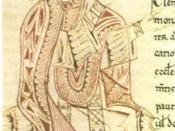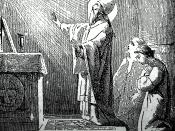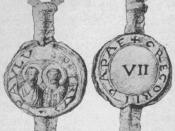After the Barbarian Invasions and the fall of Rome in 476 AD, the church stood in power providing the Germanic tribes administrative and supernatural authority. The church had a major voice primarily in religious matters and to a lesser degree in secular affairs. During the Carolingian Empire, the church began to profit from land they acquired establishing the large monasteries and dioceses, and thus began to gain secular and worldly power. Emperors and kings tried to attach themselves to the wealth and authority ecclesiastical members possessed by offering the church protection in return. During the 11th century, the church argued with the state that lay princes could not participate in ceremonies that chose bishops and abbots who were installed in their dioceses. This was the basis of the Lay Investiture Controversy. As the church and its officials gained more power secularly, the power of the emperors who allied with them became jeopardized and eventually led to the collision between church and state over the fact that church would not let the emperor interfere in any religious matters.
During the Middle Ages, the Roman Catholic Church gained power and prosperity and strengthened because of it. The church's wealth included lands, from monasteries, and money, from the buying or selling of church offices, or otherwise known as simony. The wealth of the church led to the belief that it was corrupt and that there was need for reform. The emperor also had power, and during the Carolingian Empire and beyond, the power of the emperor strengthened. Emperors became accustomed to nominate bishops within their realm because bishops formed an important element of imperial government and the emperor was more concerned that they be loyal to him than that they be morally upright. This also was a basis that the church reformers...


